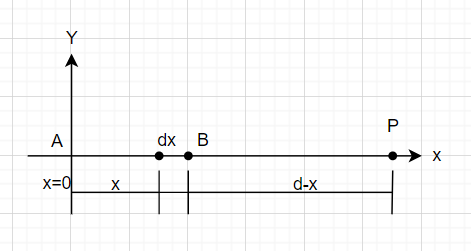
Consider a finite line charge of uniform charge density $\lambda $ and of length L lying along the x-axis from to x=0. find the field at a point along the axis at x=d.


Answer
498k+ views
Hint: First of all, we will consider an element dx and then calculate the Electric field about that dx element. After that, we will do integration of the resulting electric field expression that we found with the help of the dx element. So, as to get the Electric field expression at that particular given point which is point P.
Formula Used: Here, expression for Electric Field is :-\[E=\dfrac{1}{4\pi {{\varepsilon }_{o}}}\centerdot \dfrac{q}{{{r}^{2}}}\]
Where, E is the electric field that occurs due to charge ’q’ ,\[{{\varepsilon }_{o}}\] is the permittivity of free space.
Complete step-by-step solution:
Since,\[dE=\dfrac{1}{4\pi {{\varepsilon }_{o}}}\centerdot \dfrac{dq}{{{(d-x)}^{2}}}\]
Now, $\dfrac{dq}{dx}=\lambda $
So, $\Rightarrow dq=\lambda dx$
therefore,\[\Rightarrow dE=\dfrac{1}{4\pi {{\varepsilon }_{o}}}\centerdot \dfrac{\lambda dx}{{{(d-x)}^{2}}}\]
After integrating both sides. We get,
\[\Rightarrow \int _{0}^{v}dE=\int _{0}^{L}\left[ \dfrac{1}{4\pi {{\varepsilon }_{o}}}\centerdot \dfrac{\lambda dx}{{{\left( d-x \right)}^{2}}} \right]\]
Taking constants out of integration,
\[\Rightarrow E=\dfrac{\lambda }{4\pi {{\varepsilon }_{o}}}\int _{0}^{L}\left[ \dfrac{dx}{{{\left( d-x \right)}^{2}}} \right]\]
\[\Rightarrow E=\dfrac{\lambda }{4\pi {{\varepsilon }_{o}}}\left[ \dfrac{1}{d-x} \right]_{0}^{L}\]
After putting limits,\[\Rightarrow E=\dfrac{\lambda }{4\pi {{\varepsilon }_{o}}}\left[ \dfrac{1}{\left( d-L \right)}-\dfrac{1}{d} \right]\]
Then after Multiplying it, we get :-
\[\Rightarrow E=\dfrac{\lambda }{4\pi {{\varepsilon }_{o}}}\left[ \dfrac{-d+(d-L)}{d\left( d-L \right)} \right]\]
\[\Rightarrow E=\dfrac{\lambda }{4\pi {{\varepsilon }_{o}}}\left[ \dfrac{L}{d\left( d-L \right)} \right]\]
Electric field,\[\Rightarrow E=\dfrac{\lambda L}{4\pi {{\varepsilon }_{o}}\centerdot d\left( d-L \right)}\]
Hence, the Electric field at a point P along the axis at x=d. Having uniform charge density as well as length L lying along the x-axis from x=0 to that point is \[E=\dfrac{\lambda L}{4\pi {{\varepsilon }_{o}}\centerdot d\left( d-L \right)}\]
Additional Information: Electric field is an electric property connected with each point in space only when an electric charge is present in any form. The magnitude and direction of the electric field are expressed by the value of E and are called electric field strength or electric field intensity or you can simply call it the electric field. We can get Knowledge of the value of the electric field at a point, without having any specific knowledge of what produced the field, all that we need is to determine what will happen to electric charges close or present nearer to that particular point.
Note: Firstly, we have to find the electric field for element dx. Then only, through the integration of the elemental electric field, will we be able to get the resultant electric field for the given point. Also, try to prefer solving equations in a stepwise manner. If, doesn't want to stick anywhere and do the integration as well, put the limits carefully.
Formula Used: Here, expression for Electric Field is :-\[E=\dfrac{1}{4\pi {{\varepsilon }_{o}}}\centerdot \dfrac{q}{{{r}^{2}}}\]
Where, E is the electric field that occurs due to charge ’q’ ,\[{{\varepsilon }_{o}}\] is the permittivity of free space.
Complete step-by-step solution:
Since,\[dE=\dfrac{1}{4\pi {{\varepsilon }_{o}}}\centerdot \dfrac{dq}{{{(d-x)}^{2}}}\]
Now, $\dfrac{dq}{dx}=\lambda $
So, $\Rightarrow dq=\lambda dx$
therefore,\[\Rightarrow dE=\dfrac{1}{4\pi {{\varepsilon }_{o}}}\centerdot \dfrac{\lambda dx}{{{(d-x)}^{2}}}\]
After integrating both sides. We get,
\[\Rightarrow \int _{0}^{v}dE=\int _{0}^{L}\left[ \dfrac{1}{4\pi {{\varepsilon }_{o}}}\centerdot \dfrac{\lambda dx}{{{\left( d-x \right)}^{2}}} \right]\]
Taking constants out of integration,
\[\Rightarrow E=\dfrac{\lambda }{4\pi {{\varepsilon }_{o}}}\int _{0}^{L}\left[ \dfrac{dx}{{{\left( d-x \right)}^{2}}} \right]\]
\[\Rightarrow E=\dfrac{\lambda }{4\pi {{\varepsilon }_{o}}}\left[ \dfrac{1}{d-x} \right]_{0}^{L}\]
After putting limits,\[\Rightarrow E=\dfrac{\lambda }{4\pi {{\varepsilon }_{o}}}\left[ \dfrac{1}{\left( d-L \right)}-\dfrac{1}{d} \right]\]
Then after Multiplying it, we get :-
\[\Rightarrow E=\dfrac{\lambda }{4\pi {{\varepsilon }_{o}}}\left[ \dfrac{-d+(d-L)}{d\left( d-L \right)} \right]\]
\[\Rightarrow E=\dfrac{\lambda }{4\pi {{\varepsilon }_{o}}}\left[ \dfrac{L}{d\left( d-L \right)} \right]\]
Electric field,\[\Rightarrow E=\dfrac{\lambda L}{4\pi {{\varepsilon }_{o}}\centerdot d\left( d-L \right)}\]
Hence, the Electric field at a point P along the axis at x=d. Having uniform charge density as well as length L lying along the x-axis from x=0 to that point is \[E=\dfrac{\lambda L}{4\pi {{\varepsilon }_{o}}\centerdot d\left( d-L \right)}\]
Additional Information: Electric field is an electric property connected with each point in space only when an electric charge is present in any form. The magnitude and direction of the electric field are expressed by the value of E and are called electric field strength or electric field intensity or you can simply call it the electric field. We can get Knowledge of the value of the electric field at a point, without having any specific knowledge of what produced the field, all that we need is to determine what will happen to electric charges close or present nearer to that particular point.
Note: Firstly, we have to find the electric field for element dx. Then only, through the integration of the elemental electric field, will we be able to get the resultant electric field for the given point. Also, try to prefer solving equations in a stepwise manner. If, doesn't want to stick anywhere and do the integration as well, put the limits carefully.
Recently Updated Pages
A man running at a speed 5 ms is viewed in the side class 12 physics CBSE

The number of solutions in x in 02pi for which sqrt class 12 maths CBSE

State and explain Hardy Weinbergs Principle class 12 biology CBSE

Write any two methods of preparation of phenol Give class 12 chemistry CBSE

Which of the following statements is wrong a Amnion class 12 biology CBSE

Differentiate between action potential and resting class 12 biology CBSE

Trending doubts
What are the major means of transport Explain each class 12 social science CBSE

Which are the Top 10 Largest Countries of the World?

Draw a labelled sketch of the human eye class 12 physics CBSE

Explain sex determination in humans with line diag class 12 biology CBSE

Explain sex determination in humans with the help of class 12 biology CBSE

Differentiate between homogeneous and heterogeneous class 12 chemistry CBSE




